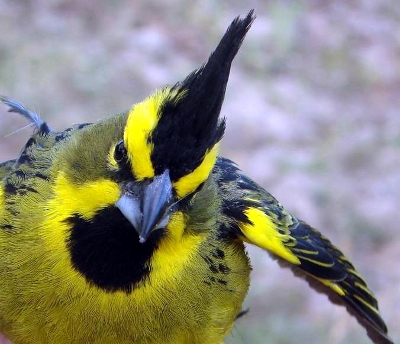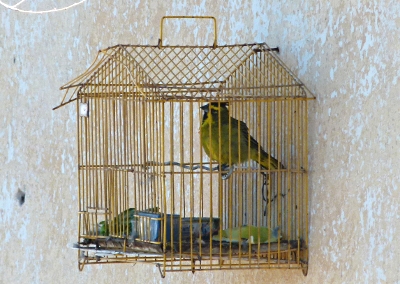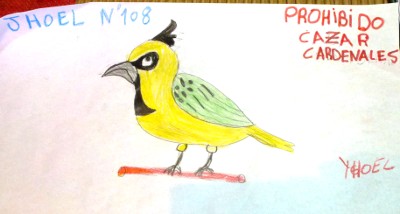By Bettina Mahler
The Yellow Cardinal (Gubernatrix cristata) is a passerine endemic of southern South America, which is currently categorized as Endangered. In the past, this species was widely distributed in the thorny deciduous shrubland forests of central Argentina, most of Uruguay and part of southern Brazil. However, for over a century there has been a continuous removal of individuals, mainly males, to commercialize them as cage birds.

Female and male Yellow Cardinal (M. Domínguez).
For more than 10 years, we have been studying the populations of the yellow cardinal (Gubernatrix cristata), mainly present in Argentina (Domínguez et al. 2020). Our studies have shed light on previously unknown aspects of this species like its reproductive biology, new threats imposed by botfly and shiny cowbird parasitism (Domínguez et al. 2014, Atencio et al. 2020), as well as genetic and behavioral population structure (Domínguez et al. 2016, 2017).
Based on this information and on surveys developed by Aves Argentinas, a Yellow Cardinal Alliance was created with governmental offices and rescue centers (Fundación Temaikén, Ecoparque) to deal with individuals confiscated from the illegal traffic (Domínguez et al. 2019). During the last years, our studies focused on evaluating the success of the recovered individuals’ reintroductions, assessing which factors were critical for the positive outcome of this conservation action (PhD thesis of M. Atencio). Currently, we are working on genomic aspects of yellow cardinals’ vulnerability to global climate change.
Related publications
Atencio M, de la Colina MA & Mahler B.Behavioural responses are associated with mortality and mobility after reintroduction in the endangered Yellow Cardinal.. Ibis, doi: 10.1111/ibi.13191. (2023).
Domínguez M, Lapido R, Gorrindo A,….. and Mahler B.A citizen science survey discloses the current distribution of the endangered Yellow Cardinal Gubernatrix cristata in Argentina.Bird Conservation International, doi:10.1017/S0959270920000155. (2020).
Atencio M, Reboreda JC and Mahler B. Brood parasitism leads to zero recruitment in the globally endangered Yellow Cardinal Gubernatrix cristata.Bird Conservation International, 32(1): 147-153 (2020).
Domínguez M, Pizzarello G, Atencio M, Scardamaglia R and Mahler B.Genetic assignment and monitoring of an endangered passerine.Journal of Wildlife Management 83: 1336-1344. DOI: 10.1002/jwmg.21718. (2019)
Domínguez M, Tiedemann R, Reboreda JC, Segura L, Tittarelli F and Mahler B.Genetic structure reveals management units for the yellow cardinal (Gubernatrix cristata), endangered by habitat loss and illegal trapping.Conservation Genetics 18: 1131-1140. (2017)
Domínguez M, Reboreda JC, and Mahler B.Effects of fragmentation and hybridization on geographical patterns of song variation in the endangered Yellow Cardinal Gubernatrix cristata IBIS doi: 10.1111/ibi.12388 (2016)
Domínguez M, Ayarragaray M, and Lapido R. Nidos de Cardenal Amarillo (Gubernatrix cristata) en la provincia de San Luis, Argentina. Nuestras Aves 60: 8-10 (2015).
Dominguez M, Reboreda JC and Mahler B. Impact of Shiny Cowbird and botfly parasitism on the reproductive success of the globally endangered Yellow Cardinal Gubernatrix cristata. Bird Conservation International - doi: 10.1017/S095927091400015X. Published online (2014).
Domínguez M. Investigación: Amenazas para el Cardenal Amarillo en Corrientes. Boletín de los Esteros Número 15 (December 2012).






